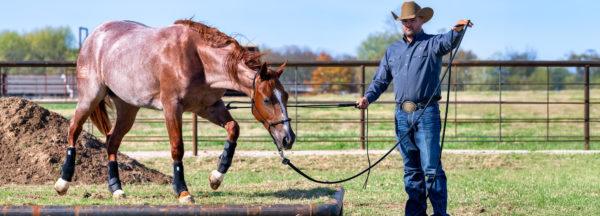Correct Halter Placement


Clinton Anderson: Correct Halter Placement - Downunder Horsemanship
Clinton Anderson from Downunder Horsemanship has developed a way to train horses, regardless of their past problems or traumas. It all begins with training the owners so they can gain their horse’s respect and understand how to properly control them. Join Clinton on his weekly endeavors of tackling some of the most challenging situations with problem horses, and problem owners. This week, we watch as Clinton answers another listener question.
This week’s question comes from Fern in Indiana. Fern wants to know what the correct placement of the halter should be for different situations. Specifically, the differences in halter position when you’re working with your horse versus when they’re tied up or during trailer loading.
Clinton confirms that the placement for your horse’s halter definitely depends on whether you’re working your horse on the ground or you’re letting him rest. When you’re giving your horse a break—whether it be tied up, preparing to load, etc.—you want to make sure that the halter is way up on your horse, where it’s kind of high on his face. The halter should be up under his jaw and secured in a tight, but comfortable way. This means that if your horse were to ever pull back or even try to rub his face on the side of an object or a fence, the halter has a very small chance of slipping up over the horse’s ears and coming off. This is the best way to keep your horse safe and secure with a halter when you’re not working.
Clinton goes on to explain that when you’re doing groundwork, the halter placement varies a little bit. Whenever you’re working your horse, you want to loosen the halter off so that it falls down to the lower part of his nose. He shows viewers the ideal spot, which is low, but not so low that it interferes with the soft part of his nose. The perfect positioning for a halter during groundwork is right where the soft part comes into the bony part of the nose. He explains that this is good because the lower the halter is on your horse’s face, the better the leverage you’ll get when you’re working together. The higher the halter placement is, the more your horse will have a tendency to resist and kind of pull against you or try to drag you around.
A lot of people don’t believe Clinton when he tells them that lowering the halter even just two or three inches can make a huge difference, but it absolutely does. Not convinced? Give it a try for yourself and see how your training changes. However, as a word of caution, always make sure that the halter doesn’t get to a point where it cuts off your horse’s ability to breathe. When it hangs too low, it can obstruct airflow, which is only going to irritate your horse. This happens when the halter presses on the soft part of the nose.
So, again, the sweet spot for working your horse is on their nose just where the soft part starts to join the bony part. When you’re tying your horse up or they’re not doing any groundwork, place that halter nice and high. Then, when you need to take off your halter, start by lowering your horse’s head and keeping it tipped towards your body. Undo the halter and gently remove it while your horse’s head remains in that tilted position. Once you remove the halter, give your horse some love and interact with them for a few minutes to create a positive connection between the halter and attention.
This comprehensive training program will streamline your journey to becoming a great horseman. Gain access to all of the training material through three different levels by joining our No Worries Club. Start your digital training experience today. Visit our homepage and download the Downunder Horsemanship app to experience the Clinton Anderson method in a whole new way. You can also purchase any of the halters seen on today’s show on our website.

